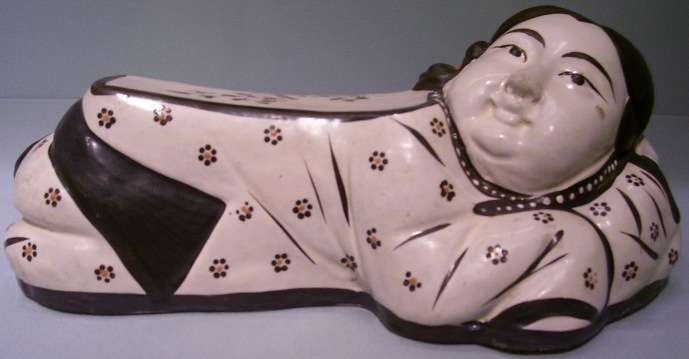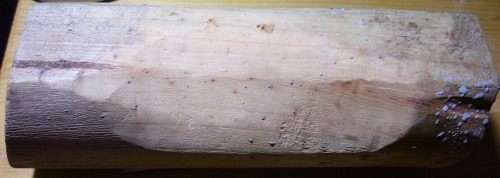Wooden Pillow
China & Egypt used wooden pillows; my recreations fail
My major experiment the summer of 200916ya was experimenting with various polyphasic sleep schedules. I am perfectly aware that the scientific evidence by Dr. Stampi and others for polyphasic sleep as a workable sleep schedule is weak, and that a reduced biphasic sleep schedule is probably the only workable alternative. But my schedule permitted it and I’ve long been curious—so I tried.
One of the issues with polyphasic sleep was that I began with the Uberman Schedule, which permits only 20 minutes. I timed myself. To put on pajamas, fluff my pillow, remove my accouterments, wrap my scarf around my eyes, and painstakingly arrange my blankets so that I could comfortably sleep on my side—it all took the better part of 10 minutes even when I did not dawdle. This was unacceptable. The lure of Uberman was that the 6 naps of 20 minutes a piece meant you only spent 2 hours a day on sleeping, not 8 or 9. At 10 minutes to actually close my eyes, I would either be forced to have only 1 hour of sleep (and not even the most enthusiastic advocates claim 1 hour is sustainable) or I would be forced to spend a full hour a day just in dressing up and dressing down—bloating the sleep portion of my schedule by 50%.
Unacceptable. Just unacceptable. I had to optimize this process.
Clothing
My first step was to abandon pajamas. If I’m sleeping for 20 or 30 minutes, it’s not worth the effort. That brings the routine is down to about a minute. I lie down, set the alarm, take off my glasses, and wrap the scarf around my head. Much more satisfactory.
Side-Sleeping
The second thing to go was sleeping on my side. I’ve side-slept all my life, but not for any particular reason. I have come to appreciate that there are disadvantages to side-sleeping. (Sleeping on my stomach is right out; I have yet to figure out how to breathe.) For example, to side sleep comfortably I require a number of blankets and a soft pillow; otherwise I am not propped up. These blankets then impose a cost which is acute in the summer: they keep one warm, very warm indeed, and one can wake up smelly and with mussed-up hair. Nor can side-sleeping be done anywhere, while a back-sleeper can simply lie down & use a book as a pillow or something.
So I determined to break my habit of side-sleeping and become a back-sleeper. It was not easy, but I persisted and now I lapse only occasionally.
The interesting aspect of back-sleeping from this summer’s perspective is my last point: you do not always need a soft pillow. The back of your head is hard bone and cushioned by hair in a way the side of your head (with its squishy ears) is not. So you can get away with a pillow which is not soft, or indeed a pillow which is quite hard. Here was an opportunity to remove not just the elaborate arrangement of blankets, but also the adjustment of the pillow. I decided: I would investigate wooden pillows!
Wooden Pillows
Wooden pillows are an unusual topic. As widely read as I am, I have seen few examples: in a few Buddhist contexts (used by monks), as relics of the ancient Egyptians, as devices employed by Japanese women to preserve their elaborate coifs, and curiously, in a Chinese context, where porcelain pillows were common—for example, here is a very nice ceramic pillow in the form of a tiger, and in my 201114ya trip to San Francisco I spotted 2 different porcelain pillows at the Asian Art Museum:

“Pillow in the form of a reclining girl, Northern China, Jin dynasty (1115–1234), Cizhou ware, high-fired ceramic with overglazed decoration, The Avery Brundage Collection, B60P422. The representation of girls on a Song pillow, rare in contrast to the frequent representations of boys, suggests a piece made for female use. This finely sculpted pillow features a young girl, her expression well detailed, accompanied by chrysanthemum and plum blossoms.”
(See also Michelle Maabelle’s superior photograph.) I also photographed a lotus leaf pillow, but Mary Harrsch did it much better than I did. The Pitt Rivers Museum in Oxford, England, includes a ‘pillow’ section among its household goods collections on the second floor, collecting wooden & ceramic pillows of all varieties from Asia and Africa especially, noting the usual summary that they can be cooler in hot climates & preserve elaborate hairstyles (noting that one African hairstyle took ~50 hours to create) and some may’ve been used with cloth pillows/
But my preliminary searches turned out very few contemporary sources. This is a little odd; intuitively I would expect that such pillows be well-studied as they are durable enough to survive centuries and they have clear practical utility as far as portability and cleanliness go – what pillow could be easier to clean than a porcelain one?
Having become a back-sleeper, I began looking for some manner of ‘hard’ pillow that I would not have to wash or adjust. But the lack of popularity meant that information, much less plans or products, was scarce indeed. I found a few links, and one or two offerings of wooden orthopedic pillows. But naught else.
Prosuming
Mark 1
I had no choice but to make my own. My first prototype was very simple. I took a long wooden pole left over from my family’s tree house and I cut off a half-meter segment. The pole was roughly circular with a planed top and bottom (so it was a hexagon), with a radius of approximately 12 centimeters. I then slept on it as usual, with my head wrapped in a scarf.
Those naps were terrible! I couldn’t figure out how to sleep on it. The few pictures I’d seen did not indicate any special well or bump for the back of the head to actually rest on, so I just left the top flat. I couldn’t put the back of my head flat down because my head would loll to the side, or my muscle tension would keep me awake, or my head lain sideways would crush my ear. I tried moving the pillow down my neck. Perhaps the pillow was supposed to fit in the gap between shoulder and lower-back-head? That did not work either. The edges abraded both my shoulders and my head still lolled from side to side.
Mark 2

The Mark 2 wooden pillow, paint-spattered years later after use in random projects
I began sanding this block down, pushing into the center so as to form a dip (when seen from the side) or a depression (seen from above) for my head to naturally be in. After several weeks, this had worked better—I was at least getting decent sleep—but it still was less satisfactory than a normal pillow.
I also tried the neck approach again, but the same lolling issue manifested.
Mark 3
Finally, I decided to revamp the design completely. For my third prototype, I took a second section from the pole, and I lashed it to the first section lengthwise. These two segments left between them a considerable depression, a void, V-shaped from the side. I began sanding vigorously, and began approximating two quarter-circles instead of two pointy lines. The lashing I modified and added some wraps lengthwise along the gap, forming a sort of net or hammock between the two segments.
This arrangement has proven to be much better.
Mark 4
The 3rd prototype also worked fairly well with side-sleeping. One’s chin and temple are flat on the two logs, and one’s delicate ear is loose in the hollow. But the pressure on the top and bottom are a bit distressing; if one tries to just put a scarf over it as padding, this merely dooms one to uncomfortable early mornings (when the padding has been pushed off and one is resting on the naked wood).
Mark 5
My current design takes the viewpoint that if one could push the pressure further up and down the head, and one removed the rope wrappings, then it might work. To do this I inserted a small rectangle of wood—a spacer—between the two main blocks and then lashed just the ends together. It was tricky, but it holds together. Without the rope chafing, it seems to work better. Even better, I’ve discovered that I can tuck the otiose corner of my blanket under my head, instead of relying on the scarf.
In the future, I think I’d like the third version to be a single piece of wood as the lashing loosens every couple of weeks. This wasn’t a big deal when I was undoing it every day to sand the blocks, but is more annoying when I’m not modifying it. The purpose was to do less maintenance, not more!
Ending
Even the mark 5 did not restore my accustomed rest, and in some respects was worse than the others. At that point, I considered my sunk costs and decided to call it quits. There may be acceptable designs—such as a mini-hammock—but there are other things to spend my time on.